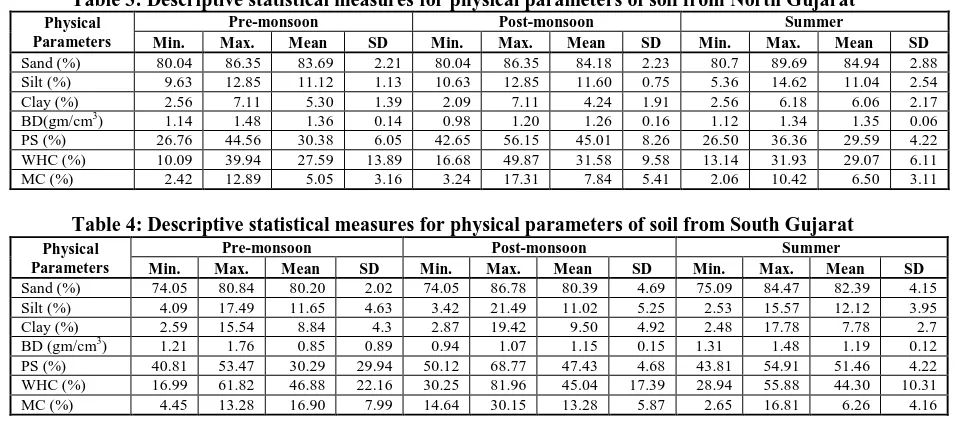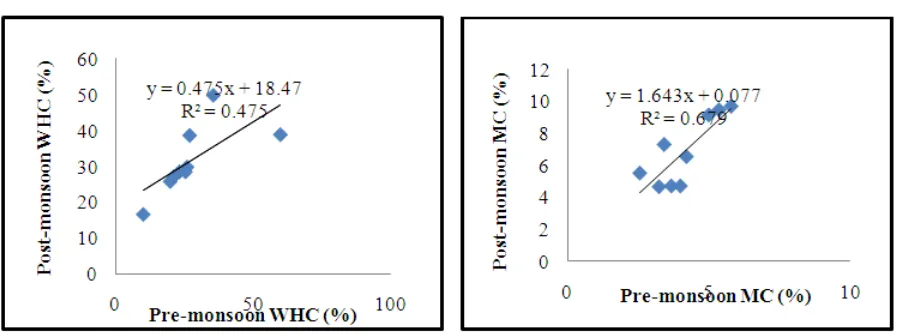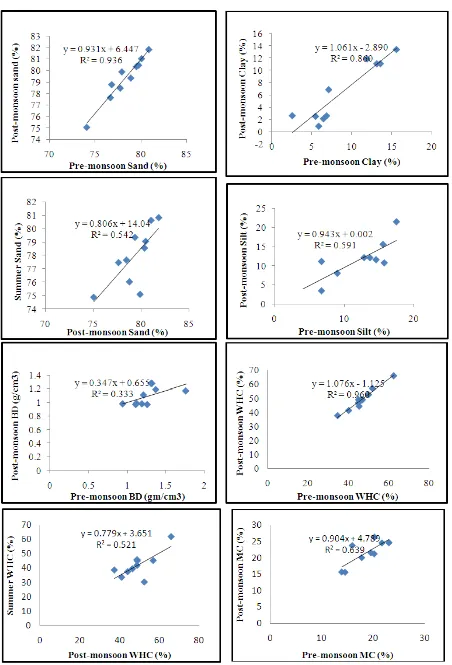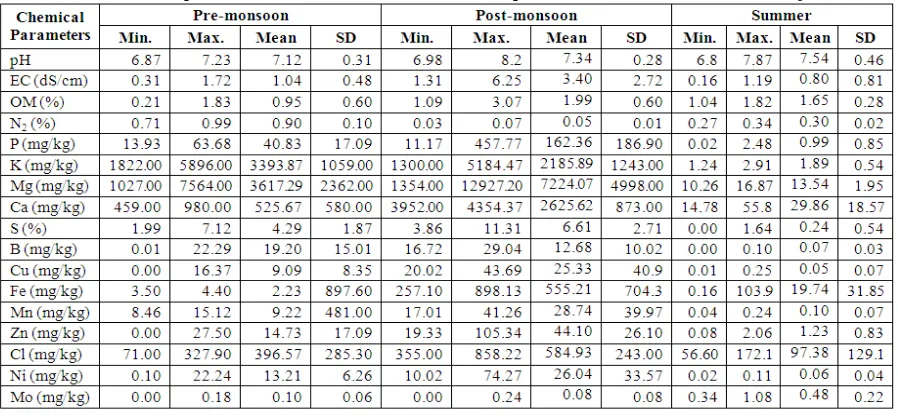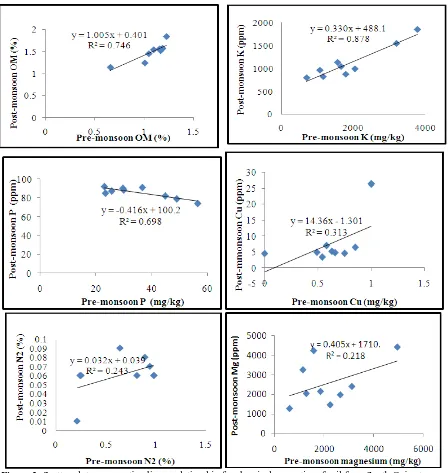e-ISSN: 2319-2380, p-ISSN: 2319-2372. Volume 8, Issue 6 Ver. II (Jun. 2015), PP. 26-36 www.iosrjournals.org
Seasonal Impact on Physical-Chemical Properties of Soil in North
and South Gujarat
Meghana P. Patel
1, Bharat Gami
2, Beena Patel
3*1
Department of Biotechnology, Hemchandracharya North Gujarat University, Patan, 384265, India.
2
Abellonagrisciences,Sydney House, Old Premchand Nagar Road,Ahmedabad-380015 INDIA
3*
AbellonCleanEnergy.Sydney House, Old Premchand Nagar Road,Ahmedabad-380015 INDIA.
Abstract: Climate change affects agriculture, food security and farmers. With this perspective, it is necessary to carry out analysis according to the geography of Gujarat, which makes the state more vulnerable to the changes in precipitation and temperature pattern. The present study precisely aims to assess the impact of these patterns on agriculturalsoilfor which the samples were collected from semi-arid region, North Gujarat and high rainfall zone viz. South Gujarat. Soil physico-chemical properties were analyzed using standard methods and the derived data was subjected to statistical analysis using IBM SPSS Ver.20. The soil porosity, water holding capacity and moisture content of North Gujarat exhibited an increasing trend from pre- to post-monsoon whereas decreasing trend was marked during the summer.The major ion chemistry reveals that chloride is the most dominant anion for all the seasons and both the zones. The variation of 54.21% and 52.16% with respect to sand and moisture content of South Gujarat soil of summer can be predicted from that of the post-monsoon. With the change in precipitation and temperature regimes, physical properties and trace element concentration varies significantly. In order to cope up in this avenue, conventional agronomic practices should be revised in accordance to the region.
Keywords:Correlation, Gujarat, Seasons, Soil, Regression.
I. Introduction
According to the IPCC, global temperatures are expected to increase between 1.1 to 6.4 °C during the 21st century and precipitation patterns will be altered. Soils are intricately linked to the atmospheric/climate system. Because of this, altered climate will have an effect on soil processes and properties. [1]. Climate change will also influence the global precipitation patterns, altering both the amount of precipitation received and the distribution of precipitation over the course of an average year in many locations [2].In a semi-arid steppe, it was observed that soil warming and drying led to 32% reduction in soil C over a five year time period, a lot more rapid reduction in soil C than reductions observed due to increased tillage [3].Soils are essentialfor food security and climate change has the potential to threaten food security through its effects on soil properties and processes [4]. In order to mitigate losses in agricultural productivity due to seasonal climatic changes like heavy rainfall, drought, etc., there is a need to monitor physical-chemical properties of soil as it has a direct impact on soil health and subsequent crop yields.
Though several international interventions have taken a step forward to prevent it, there is a need to carry out disaggregated analysis at the regional level, particularly, within the state in order to fine tune the hot spot areas that need immediate interventions. Gujarat is the state with semi-arid zones and encompasses the longest coastline. These characteristic features make the state relatively more vulnerable to climate change.Agriculture in Gujarat is characterized by natural disparities such as
Drought prone areas and lowest annual rainfall amounting to only about 345 mm in the North and NorthWest end of the states which are prone to frequent scarcity.
Assured and highest annual rainfall amounting to about 2500 mm at the South-East end which are prone to frequent floods.
Thus, output of the agricultural sector in Gujarat has been largely dependent on the south-west monsoon. The state frequently experiences erratic behavior of the south-west monsoon [5].
Semi-arid zone, North Gujarat, South Gujarat and high rainfall zone were selected in order to assess and compare impact of precipitation and temperature regimes on agricultural soil.
II. Materials & Methods
1. Sample collection
Total nine and ten composite agriculture soil samples were collected from northern and southern part of the Gujarat respectively during pre-monsoon, post-monsoon and summer seasons from year 2013-2014. The sample sites were namely Pethapur, Ratanpur Kolad, Vantda, Balisana, Viramgam, Detroj, Talod, Bhiloda (North Gujarat) and Amod, Amroli, Rajpipla, Ankaleshwar, Vyara, Ukai Pathri, Gandevi, Vansda, Ahwa(South Gujarat). The samples were collected up to 15 cm soil depth (plough layer) using an auger and required amount of soil samples were taken by quartering method. Root part and other plant residues were removed from the soil and then these soil samples were air dried, sieved with <2.0mm test sieve for further soil analysis (Soil testing of India, 2011) [6].
2. Soil Analysis Methods
Soil physical properties like soil texture [sand (%), silt (%) and clay (%) content], bulk density (gm/cm3), water holding capacity (%) and porosity (%) were analyzed using standard methods given in Table1.
2.1.Physical parameter analysis
Table 1: List of methods for soil physical parameter analysis
Parameter Method used
Moisture Content (MC) Gravimetric method
Bulk Density (BD) Undisturbed soil-core method Porosity (PS) Using bulk & particle density Water Holding Capacity (WHC) Veihmeyer and Hendrickson method Soil texture (Particle size distribution) Bouyoucos Hydrometer method
2.2.Chemical parameter analysis
The chemical parameters viz. pH, electrical conductivity (dS/cm), organic matter (%), available nitrogen (%), phosphorus (mg/kg), potassium (mg/kg), magnesium (mg/kg), calcium (mg/kg), available sulfur (%), chloride (mg/kg), boron (mg/kg), iron (mg/kg), copper (mg/kg), zinc (mg/kg), manganese (mg/kg) and molybdenum (mg/kg) were analyzed using standard soil testing methods as shown in Table 2-
Table 2: List of methods used for analysis of chemical properties of soil
Parameter Method used
pH pH meter (Auto pH system PM300, Eutech Instruments)
Electrical conductivity (EC) Conductivity meter (HI-2300 EC/TDS/NaCl meter, Hanna Instruments Organic matter (OM) Walkley-Black wet combustion
Nitrogen (N2) Kjeldahl
Phosphorus (P) Olsen
Potassium (K), Calcium (Ca), Stanford English method (by Flame photometer 128, Systronics) Available sulfur (S) Spectrophotometric
All soil sample analysis results were statistically analyzed using SPSS statistical software version-20 (IBM) descriptive statistics and Pearson correlation. Regression analysis was performed between physico-chemical parameter regimes of soil from eight different agro-climatic zones and with respect to seasons to understand variation between all the samples characteristics. Statistical significance was accounted when p value was <0.05 &<0.01.
III. Results And Discussion
The motive behind examining variations by comparing these three periods was to study changes in soil fertility due to changes in precipitation and temperature regimes of the northern and southern parts of Gujarat.
1. Physical parameters
were subjected to descriptive statistical measures. The minimum, maximum, mean and standard deviation values for North and South Gujarat generated were presented in Table 3 and 4 respectively.
Soil samples did not display any significant difference in mean values of sand, silt and clay content in three seasons inthe North Gujarat zone. A slight decrease in bulk density was observed in post-monsoon soil samples due to lower rainfall zone. PS, WHC and MC showed an increasing trend from pre- to post-monsoon whereas a decreased trend was marked during the summer.
Descriptive analysis of South Gujarat zone soil unveiled a slight difference in sand, silt and clay % which might be due to heavy rainfall. The maximum values of BD were 1.48gm/cm3 (pre-monsoon), 1.20 gm/cm3 (post-monsoon) and 1.35gm/cm3 (summer) indicating low to high low organic matter content. The similar trend was revealed for PS, WHC and MC.
The Pearson correlation was used to establish the relationship between two physical variables or physical-chemical parameters. The degree of linear relationship between soil quality parameters is measured by the simple correlation coefficient (r) along with the level of significance (2-tailed). It is presented in Table 5.
For all the three seasons, a strong negative correlation for sand-silt pair (Pr. r=- 0.836, Po. r= -0.776, Su. = -0.911), a strong positive correlation for WHC-MC (Pr. r=0.904, Po. r= 0.886, Su. = 0.728) existed which indicates that WHC results in compaction of soil particles and increases capacity to retain soil water content. The inference includes that soil BD is negatively correlated to soil WHC and MC.
During pre-monsoon season, sand is negatively correlated to MC and OM. It is mainly due to less soil OM content which causes less aggregation of soil particles particularly the sand particles. Clay particles demonstrated positive correlation with WHC, MC and EC due to compact nature of clay particles with large number of pores which helps in retaining soil water and nutrients too.
Sand particle content during post-monsoon season showed positive correlation with BD (r= 0.518) as a result of less aggregation of sand particles whereas reverse was the case for silt (r= -0.398). Silt % content and PS were correlated. A very weak correlation existed between soil pH and EC indicating concentration of ion present in the soil.
A negative correlation was observed for sand-OM, BD-OM, BD-K and WHC-OM whereas positive correlation for silt-PS, silt-OM, PS-WHC existed for summer season samples.
Porosity of the soil samples from post-monsoon and summer seasons showed negative correlation with the sand particle content and BD whereas moisture content increases with increase in PS.
Table 3: Descriptive statistical measures for physical parameters of soil from North Gujarat
Physical
Table 4: Descriptive statistical measures for physical parameters of soil from South Gujarat
Physical
2. Chemical parameters
The basic statistics for chemical properties of soil from North Gujarat is summarized in Table 6. The pH showed neutral nature of soil during pre-monsoon and summer season. pH trend changed from slightly acidic to slightly alkaline nature post monsoon. ECvalues increased on comparing mean values with post-monsoon EC of soil in North Gujarat. High ionic concentration might be the root cause behind this. The soil OMcontentshowed variations with respect to change in season. However, available N2concentration decreased
after monsoon. It again reached to normal level during summer. For samples from all the three seasons, Mg, Kand Ca ranked first, second and third respectively with respect to its concentration. When mean for trace element concentration compared, it was observed that in pre-monsoon and summer Fe content was higher than Mnand Zncontent on the other hand concentration of Fe found to be lower than Zn but higher than Mn in summer season. Overall comparing mean values, high concentration of all macro and micronutrients except N2
was observed in post-monsoon season. Clis the most dominant anion whereas phosphorus ranked second and then B concentration was led by S and Mo. This pattern was observed in all the seasons whereas Ni content was least compared to other trace elements.
Soil samples from South Gujarat zone of pre-monsoon, post-monsoon and summer seasons were analyzed for their chemical properties and were further subjected to descriptive statistical measure which includes maximum, minimum, mean and standard deviations. The results are displayed in Table 7.The pH nature of soil in pre-monsoon and summer was neutral (Pr 6.87 to 7.23), whereas in post-monsoon season it changes from neutral to alkaline nature (Po 6.98 to 8.20). The maximum values of EC were 1.72, 6.25 and 1.19 dS/cm in pre-monsoon, post-monsoon and summer season respectively. The results demonstrated that soil OM is between 0.21 to 1.83 % in pre-monsoon, 1.09 to 3.07 % in post-monsoon and 1.04 to 1.82 % in summer. Soil N2concentration however, was found to be decreased in post-monsoon than pre-monsoon season. The major ion
chemistry reveals that Mg2+ is the most leading cation in pre- and post-monsoon season while in summer Fe was found to be dominant cation. Cl- is the most supreme anion in all the three seasons. An array of abundance of remaining cations was differing season wise. In pre-monsoon season, K concentration was higher than Fe than Ca than trace elements, Zn, Ni, Cu and Mn. Ca and K were the second leading cation whereas, the mean concentration of Mn, Ni and Cu showed same descending order in post-monsoon and summer season. The overall concentration of pattern of the anions other than Cl was same for pre- and post-monsoon season samples phosphorus concentration was higher than boron, sulfur and molybdenum whereas in summer concentration of phosphorus was highest but sulfur had more traces than molybdenum and at the last boron.
The correlation analysis results for seventeen soil chemical parameters for all the three seasons are shown in Table 8. Table shows the degree of linear association between any two chemical parameters as measured by the simple correlation coefficient (r).
A positive correlation was observed among the trace elements viz. Cu-Fe, Cu-Mn, Cu-Zn, Zn, Fe-Ni, Mn-Zn, and Zn-Ni which indicates that all of them have originated from the same source. Among the macro elements, P positively related to trace elements, Fe and Zn indicated complex formation between anion and cations. In pre-monsoon season, soil OM content positively correlates to WHC; MC indicates that OM increases aggregation of soil particles and water retention capacity of soil. It also negatively relates to BD due to a less aggregation of soil particles and less organized pores [7]. Chemical parameters like K, Ca, B, Cu and Cl is positively correlated to organic matter indicating that all of them have originated from the same source. The increase in Cl ion concentration contributes to increase in EC which can be indicated by positive correlation between EC and Cl. A positive correlation existed between Cl and Zn (r= 0.806), Cu (r= 0.839), Fe (r= 0.347), Mn (r=0.307), Ni (r= 0.397). Phosphorus exhibited correlation with Mn.
Table 6: Descriptive statistical measures for chemical parameters of soil from North Gujarat
Table 7: Descriptive statistical measures for chemical parameters of soil from South Gujarat
The Fig. 3 represents seasonal variations in soil chemical properties of North Gujarat zone. This zone showed 74.63%, 24.37%, 69.81%, 87.8%, 21.84%, 31.35% variations in OM, N2, P, K, Mg and Ca content of
post-monsoon season. It can be predicted from that the pre-monsoon season. For post-monsoon and summer season no significant predictions were obtained.
The South Gujarat zone showed 80.65%, 59.33%, 75.09%, 68.15%, 86.5% and 33.62% of variation in OM, Mg, Ca, B, Cu and Cl content of post-monsoon season. This can be predicted from the pre-monsoon season. While in summer season, only N2 and K content can be predicted from the parameters of the
post-monsoon season. The variations are represented in Fig. 4.
Figure 3: Scatter plots representing linear relationship for chemical properties of soil from South Gujarat zone
Figure 4: Scatter plots representing linear relationship for chemical properties of soil from South Gujarat zone
DOI: 10.9790/2380-08622636 www.iosrjournals.org 36 | Page
IV. Conclusion
Results and discussions have revealed that the physico-chemical properties of the soil under North and South Gujarat zones significantly vary among the variables. With the change in precipitation and temperature regimes, physical properties and trece element concentration varies significantly. In the high rainfall region, climate directly affects the rate of weathering which further results in the change of sand, silt or clay particle percent in the soil. Due to high summer temperatures, rate of evaporation increases, which results in less moisture content and water holding capacity. Though higher summer temperature leads to soil salinization but the same condition was not observed in these findings for the semi-arid, North Gujarat zone.
As North Gujarat is semi-arid region, soil and sand percent was higher which makes the soil of this zone more susceptible to heavy precipitation and temprature regimes. Heavy rainfall during year 2013, resulted in increaesed concentration for macro-nutrients like N2, P, K, Mg, Ca and physical properties like water holding
capacity. Elevated levels of macro-nutrients like phosphorus and potassium at some of the locations in this region during pre-monsoon was a result of use of excessive dose of fertilizers and poor drainage condition of soil in this area. It resulted in the increased levels in the post-monsoon season. Soil bulk density was found to be higher in this zone due to sandy texture of soil.
The soil from South Gujarat zone showed high concentration of the trace elements like Zn, Fe, Cu, Mn during post-monsoon season due to increase in leaching rates in well-drained soils as a result of heavy rainfall. Increased soil organic matter level was observed as temperary flooding which causes water saturation. The soil porosity, water holding capacity, moisture content was found to be at higher side than that of North Gujarat zone because of high clay percent. A high degree of reverse correlation between organic matter and bulk density exists. So it can be concluded that bulk density is indirectly dependent on the available micronutrients in the soil.
In accordance with these changes in physico-chemical properties due to rainfall or temperatures, improvements and adaptations in conventional agronomic practices is very essential. The region specific strategies particularly suited to semi-arid and heavy rainfall regions should be devised.
Acknowledgements
This work is a part of research thesis for the degree of Doctor of Philosophy (Ph.D.) of Mrs. Meghana P. Patel (Registration No. 001871) at Department of Biotechnology, Hemchandracharya North Gujarat University, and Patan. Authors are thankful to the Directors at Abellon CleanEnergy Ltd and Abellon Agrisciences, Ahmedabad for providing infrastructural support.
References
Journal Papers:
[1]. Eric C. Brevik, The Potential Impact of Climate Change on Soil Properties and Processes and Corresponding Influence on Food Security, Departments of Natural Sciences and Agriculture and Technical Studies, Dickinson State University, Dickinson, ND, 2013.
[2]. Solomon, S., Qin, D., Manning, M., Chen, Z., Marquis, M., Averyt, K.B., Tignor, M., Miller, H.L., Eds., IPCC. Summary for Policymakers. In Climate Change 2007: The Physical Science Basis; Contribution of Working Group I to the Fourth Assessment Report of the Intergovernmental Panel on Climate Change; Cambridge University Press: Cambridge, UK, 2007; pp. 1–18.
[3]. Link, S.O.; Smith, J.L.; Halverson, J.J.; Bolton, H., Jr. A reciprocal transplant experiment within a climatic gradient in a semiarid shrub-steppe ecosystem: Effects on bunchgrass growth and reproduction, soil carbon, and soil nitrogen. Glob. Change Biol. 2003, 9, 1097–1105.
[4]. Brevik, E.C. Climate Change, Soils, and Human Health. In Soils and Human Health; CRC Press: Boca Raton, FL, USA, 2013; pp. 345–383
[5]. Mrutyunjay Swain, S. S. Kalamkar, Kalpana M. Kapadia, AERC report-state of Gujarat agriculture submitted to the Ministry of Agriculture, Government of India, New Delhi, 2011-12.
[6]. Department of agriculture & cooperation, methods manual-soil testing in India, ministry of agriculture, Government of India, January, 2011.
Proceedings Papers:
[7]. R.O. Curtis, B.W. Post, “Estimating Bulk density from organic matter content in some Vermont forest soils”, Soil science society American proceedings, 1964, Vol 28, pp. 285-286.
Chapters in Books:

